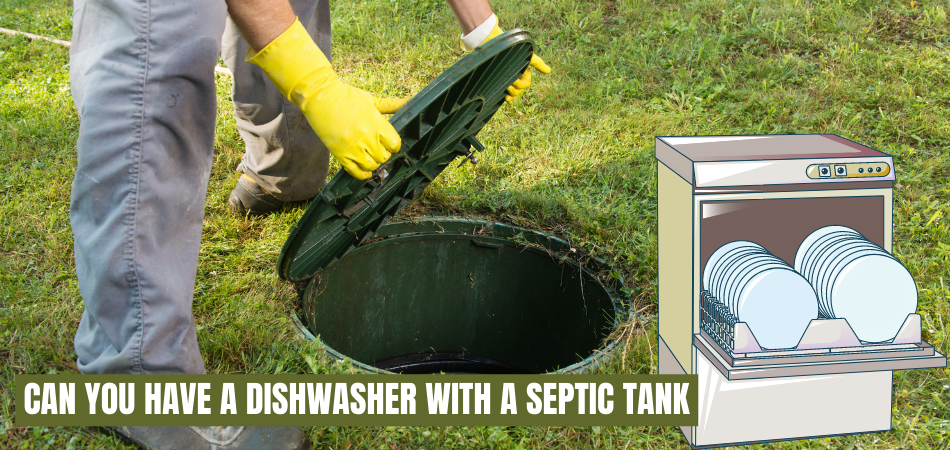Dishwashers are a great addition to modern housing to clean dishware and other kitchen utilities without any manual scrubbing or rinsing. Once you have properly installed the dishwasher, you practically automate the washing process except for the loading and unloading.
However, one thing that can become an issue if not taken care of, is considering the drainage system. Just like wastewater from other sources, dishwasher wastewater will also go to the septic tank (if you have a septic tank installed.) And unfortunately, inappropriate usage of the dishwasher can damage the septic system.
In that case, if you’re wondering whether can a dishwasher overflow and damage a septic system or not, the short answer is YES. But that’s the norm if you’re installing and using the dishwasher correctly. Let’s dive into the good practices and discover reasons for overflow and damage alongside the fixing process.
Contents
Can You Have a Dishwasher with a Septic Tank?
If you’re new to using a dishwasher, knowing how a dishwasher works is a must. Things like how the water inlet and outlet systems work and everything in between. It works through hot water and detergent to clean the dishes and then drain the dirty water.
However, sometimes the use of dishwashers can cause problems with bad home plumbing systems, including septic tanks, the final disposal of the wastewater.
Using a chemical-based detergent as well as a dishwasher that consumes a lot of water can damage the septic system. In that case, you can use a good quality and safe dishwasher for septic systems to prevent further damage to the septic tank.
And most of the modern dishwashers are designed in a way that devours considerably much less water. When you use a quality dishwasher with appropriate cleaning solutions, you can easily have a dishwasher with a septic tank without any issues.
Can A Dishwasher Overflow And Damage A Septic System?
The dishwasher is a simple and innovative device that helps to wash your dishes more efficiently and effortlessly. But the fact is using a dishwasher to wash your dishes can harm your septic tank.
Wondering how a dishwasher overflows and damages a septic system? Here we’ve discussed the things that can contribute to septic tank issues and how to avoid them. Have a look:
1. Using More Water
If you’re using a traditional dishwasher in your home, it can damage your septic system. And the reason is most of the conventional dishwashers use a lot of water for performing the dishwashing.
However, you can go for new or modern dishwashers as they consume a meager amount of water to ensure efficiency. Alongside using modern automatic dishwashers, you can follow some below steps to eliminate septic tank damage issues caused by dishwashers. Have a look:
- The best thing to reduce any type of issues with your dishwasher and septic tank is to use the dishwasher when it’s full. Avoid using the dishwasher when half empty or using it multiple times a day.
- Try to use the dishwasher when you’re not using any other appliances that can also drain a lot of water. In that case, the best solution would be to run the dishwasher late at night. Or you can also fire up the dishwasher in the middle of the night to ensure less water load in the septic tank.
In short, ensuring less water load in your septic system will keep the tank at the top.
2. Using Chemicals to Clean the Dishes
Another thing that causes damage to septic tanks is the use of chemical-based products. Don’t get it? No worries, follow the section below:
Antibacterial Dish Detergent:
If you have a septic tank in your home and use a dishwasher, then you should strictly avoid antibacterial dish detergent. That is because the antibacterial dish detergent can kill the beneficial bacteria that help to break the waste.
Phosphate:
Phosphate is another effective component that you’ll usually find in most dishwashing detergents. This dishwashing detergent can threaten the good enzymes and bacteria in the septic tank and cause overflow or clog issues.
Chlorine:
Chlorine is another harmful chemical that can harm your septic tank if you use it to wash your dishes. This ingredient kills bacteria which can also kill the beneficial bacteria in the septic tank.
You shouldn’t use any dishwashing detergent that can kill the good and beneficial bacteria in your septic tank. Killing your septic tank bacteria will result in untreated sewage clogging your pores, raising the wastewater level.
In short, using dishwashing detergent that can kill bacteria can cause an overflow issue and also cause damage to the septic tank.
3. Large Food Residue
Another thing that can affect the septic tank because of a dishwasher is large food residue and particles. If you load different dishes in the dishwasher with foods, that can cause issues to your septic tank. After washing the undigested food will go to the septic tank with wastewater and result in overflow and clogging issues.
These are some of the aspects that can overflow and damage your septic tank because of a dishwasher. So if you’re planning to get a dishwasher or have one, consider these aspects to prevent all types of possible issues.
How Do You Connect a Dishwasher to a Septic System
When it’s about connecting a dishwasher to a septic system, it doesn’t mean you have to connect the dishwasher to the septic tank directly. Your home’s wastewater goes to the septic tank with a single or primary line.
Although there are many types of dishwashers, you have to use them in your kitchen to get clean water and to drain the wastewater. You can use your sink’s drainage system to drain from your dishwasher or can make a separate line for the dishwasher itself.
In that case, if you’re wondering how to connect the dishwasher drain line to your sink’s drain system, follow the section below:
Connect the Drain Hose
The very first thing you have to do is connect the dishwasher drain line into the dishwasher’s drain port. Don’t forget to secure the drain line and drain port connection through the provided securing tools.
Connect the Drain Line to the Sink Drain System
Your kitchen has different types of wastewater drain systems, and most of the sink has a p-trap or garbage disposal drain system. Well, no matter what sink water drain system you have, we’ll discuss both of them. Check out the section below:
P-trap:
If you have a p-trap drain system in your sink, then you can simply connect the dishwasher drain line to it. However, you have to ensure that your sink’s p-trap has a spigot branch to connect the dishwasher drain line.
Simply attach the dishwasher drain line to the p-trap’s spigot branch and seal the connection appropriately. Moreover, you must remember that the drain hose needs to be looped above the primary connection.
Garbage Disposal:
On the other hand, if you have a garbage disposal (not the one you put a bin bag in) in your sink system, you can easily attach the dishwasher drain line to it. And it’s pretty easy to attach a dishwasher drain line to garbage disposal. Follow the below steps to do it:
- Connect the drain line into the dishwasher’s drain port and then connect the other end to the disposal. Remember to keep the drain hose looped above from the main connection.
- However, if you’ve never used the disposal with a dishwasher before, you have to remove the drain tube plug. Use a hammer and screwdriver to remove the plug.
Once you remove the drain tube plug, use needle-nose pliers to remove the plug. And simply attach the hose or line to the disposer or the drain pipe of disposal, and you’re done.
Dos and Don’ts for Septic Systems
No matter if you have a septic system or are about to install it, it’s always a good idea to know the dos and don’ts of septic systems. Following the proper do’s & don’ts can significantly increase the tank’s lifespan. And here we’ve included some of the common best practices with your septic tank. Have a look:
Basic Do’s & Don’ts
Here we’ve included some of the basic dos & don’ts, have a look:
Dishwasher Do’s & Don’ts
Conclusion
Washing dishware and other cooking and eating items is a tedious process that nobody loves or enjoys. However, you can make this tedious process easy by using a dishwasher. But the fact is if you have it connected to your septic system, then the wrong usage of the dishwasher can harm the tank or overflow it.
Besides, not using proper dishwashing methods can also clog pipes and also raise the wastewater level. All these issues won’t be a thing to bother about if you know the right way of using the machine. Now you know can a dishwasher overflow and damage a septic system or not and how to prevent these conditions. You also should follow the best practices and the things to avoid with your dishwasher when you the machine connected to a septic tank.




